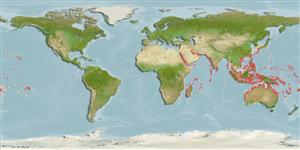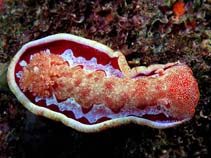Hexabranchus sanguineus (Rüppell & Leuckart, 1828)
Spanish dancer| Native range | All suitable habitat | Point map | Year 2050 |

|
| This map was computer-generated and has not yet been reviewed. |
| Hexabranchus sanguineus AquaMaps Data sources: GBIF OBIS |
Classification / Names Common names | Synonyms | CoL | ITIS | WoRMS
Gastropoda | Nudibranchia | Hexabranchidae
Environment: milieu / climate zone / depth range / distribution range Ecology
Benthic; depth range 1 - 50 m (Ref. 121225), usually 10 - 20 m (Ref. 866). Tropical; 37°N - 36°S, 30°E - 144°W
Distribution Countries | FAO areas | Ecosystems | Occurrences | Introductions
Indo-Pacific: from East Africa to Red Sea, east to French Polynesia, north to Japan, and south to Australia and New Caledonia.
Length at first maturity / Size / Weight / Age
Maturity: Lm ? range ? - ? cm Max length : 25.0 cm TL male/unsexed; (Ref. 100471)
Maximum length is based on data from Marshall Islands (Ref. 100471). Found in coral reefs at depths of 10 to 20 m (Ref. 866). Derives a potent chemical defense from Halichondria sp., a sponge that it eats. It displays a spectacular swimming response - it throws its body into sweeping dorsoventral flexions creating synchronous undulations through its broad and vividly patterned red and white mantle (Ref. 100471).
Life cycle and mating behavior Maturity | Reproduction | Spawning | Eggs | Fecundity | Larvae
Eggs are deposited as coiled rosettes on rocks and coral rubble (Ref. 100471).
Main reference
References | Coordinator | Collaborators
Gosliner, T. 1987. (Ref. 866)
IUCN Red List Status (Ref. 130435)
CITES status (Ref. 108899)
Not Evaluated
CMS (Ref. 116361)
Not Evaluated
Threat to humans
Harmless
Human uses
Fisheries: commercial
| FishSource | Sea Around Us
Tools
More information
Internet sources
BHL | BOLD Systems | CISTI | DiscoverLife | FAO(Publication : search) | Fishipedia | GenBank (genome, nucleotide) | GloBI | Gomexsi | Google Books | Google Scholar | Google | PubMed | Tree of Life | Wikipedia (Go, Search) | Zoological Record
Estimates based on models
Preferred temperature
(Ref. 115969): 24.7 - 29.3, mean 28.2 (based on 2479 cells).
Price category
(Ref. 80766):
Unknown.
Nutrients: Calcium = 126 [75, 177] mg/100g; Iron = 4.79 [1.67, 7.92] mg/100g; Protein = 15.9 [14.8, 16.9] %; Omega3 = 0.331 [0.263, 0.400] g/100g; Selenium = 57.8 [48.5, 67.2] μg/100g; VitaminA = 0 μg/100g; Zinc = 1.97 [0.92, 3.02] mg/100g (wet weight).



